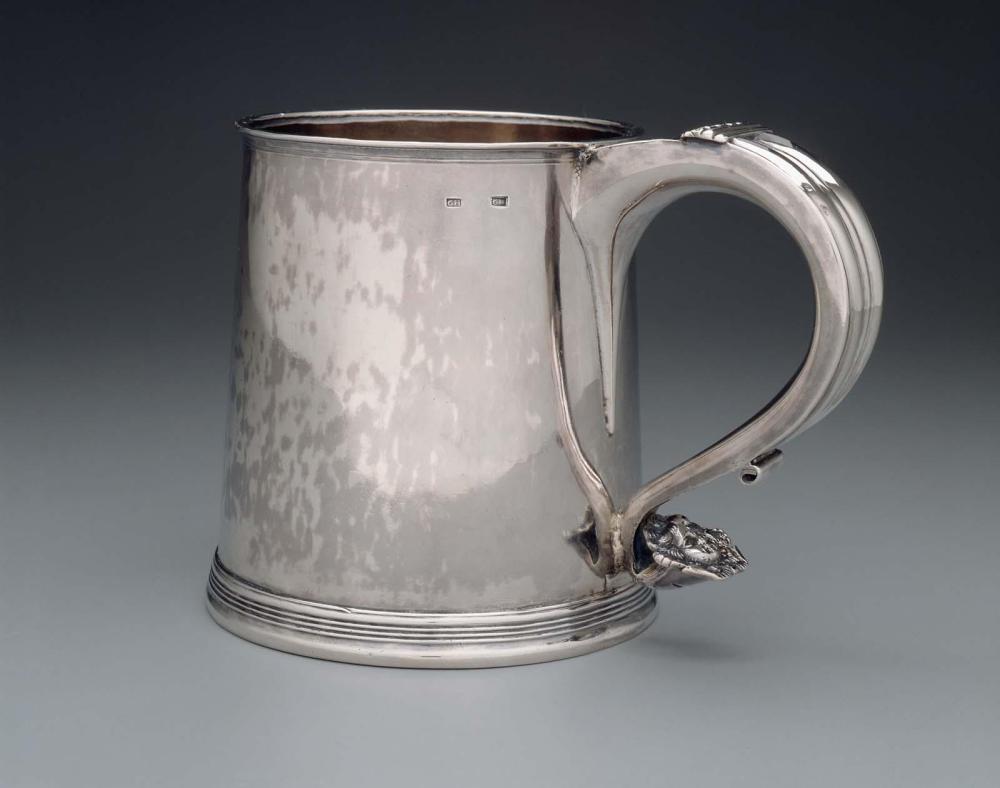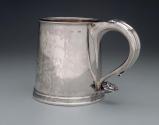Advanced Search
Tankard (missing lid)
George Hanners, Sr. (American, about 1696–1740)
1717–30
Object Place: Boston, Massachusetts
Medium/Technique
Silver
Dimensions
14 x 20 x 11 cm (5 1/2 x 7 7/8 x 4 5/16 in.)
Credit Line
Gift of Mrs. Elliot P. Cogswell
Accession Number1991.661
NOT ON VIEW
CollectionsAmericas
ClassificationsSilver hollowware
George Hanners Sr. may have trained under Boston silversmith Andrew Tyler (1692/93 – 1741), for he witnessed the will of Tyler’s mother in 1716/17. He had artisanal dealings with silversmiths Thomas Mullins (1680 – 1744) and Benjamin Hiller (1687/88 – about 1745) and in 1739 successfully sued Thomas Townsend (1703/4 – 1757) for nonpayment for a ring, tankard, gold, several pounds of allum, and two nests of crucibles. The suit demonstrates Hanners’s ability to produce hollowware and jewelry for others to retail and to provide supplies to fellow craftsmen.
During his short career, spent “at his House at the Dock-Head, Boston,” Hanners produced much hollowware but comparatively little flatware. He fashioned mourning rings, as noted in at least two estate records, for which he may have used the “Deaths head Stamp” listed in the detailed inventory of his tools. Hanners made ecclesiastical silver for Second Church, Boston; First Church, Woburn; and other congregational churches farther afield in Greenland, New Hampshire, and Branford, Connecticut.
Stylistically, this tankard may be the earliest of its type by the smith. The ribbed handle, with its delicate butterlike scroll, was already outdated when Hanners made it after completing his apprenticeship about 1716. Perhaps he had a model to draw upon, since Andrew Tyler, who has been theorized as Hanners’s master, was not known to fashion such intricate handles.
This silver tankard and its related porringer (cat. no. 63) were made for the Rev. Samuel Phillips and his wife, Hannah (White), of Andover, a few years after their marriage in 1711. The two pieces were nearly contemporaneous, as is suggested by the distinctive notations found on each base, possibly in Hanners’s own hand. The scratch weight engraved on the tankard’s base, typically a guide to an object’s original weight, is twelve ounces more than its current weight, proving that the lid was later removed. Despite this lack, the presence of two rare “GH” touches within rectangles, together with a pair of Hanners’s better-known shield marks, make this work an extremely rare and significant document of the silversmith’s skill.
This text has been adapted from "Silver of the Americas, 1600-2000," edited by Jeannine Falino and Gerald W.R. Ward, published in 2008 by the MFA. Complete references can be found in that publication.
During his short career, spent “at his House at the Dock-Head, Boston,” Hanners produced much hollowware but comparatively little flatware. He fashioned mourning rings, as noted in at least two estate records, for which he may have used the “Deaths head Stamp” listed in the detailed inventory of his tools. Hanners made ecclesiastical silver for Second Church, Boston; First Church, Woburn; and other congregational churches farther afield in Greenland, New Hampshire, and Branford, Connecticut.
Stylistically, this tankard may be the earliest of its type by the smith. The ribbed handle, with its delicate butterlike scroll, was already outdated when Hanners made it after completing his apprenticeship about 1716. Perhaps he had a model to draw upon, since Andrew Tyler, who has been theorized as Hanners’s master, was not known to fashion such intricate handles.
This silver tankard and its related porringer (cat. no. 63) were made for the Rev. Samuel Phillips and his wife, Hannah (White), of Andover, a few years after their marriage in 1711. The two pieces were nearly contemporaneous, as is suggested by the distinctive notations found on each base, possibly in Hanners’s own hand. The scratch weight engraved on the tankard’s base, typically a guide to an object’s original weight, is twelve ounces more than its current weight, proving that the lid was later removed. Despite this lack, the presence of two rare “GH” touches within rectangles, together with a pair of Hanners’s better-known shield marks, make this work an extremely rare and significant document of the silversmith’s skill.
This text has been adapted from "Silver of the Americas, 1600-2000," edited by Jeannine Falino and Gerald W.R. Ward, published in 2008 by the MFA. Complete references can be found in that publication.
DescriptionThis short-bodied cylindrical tankard has straight sides that taper inward toward the rim. No center point is visible, but clearly the vessel was raised. Finely stepped applied molding on the base is repeated in a smaller, more delicate version at the lip. The lid and hinge plate were removed at an unknown date. The hollow seamed scroll handle has three ridges running vertically between a punched meander decoration near the hinge and a curled device below; a cast cherub perches on an upward-bent terminus. A cleanly cut crescent-shaped air vent is located beneath the terminal. The handle is soldered to the body at the top join with a long slender rattail. Below the terminus is a small rectangular repair, which partly remedied the metal fatigue on the inner walls.
Marks
To left of the handle are two examples of the touchmark "GH" in roman capitals within a rectangle. Underneath the tankard are two strikes of "GH" in roman capitals within a crowned shield and a device below.
Ada Mark E11977
Ada Mark E11977
InscriptionsOn base below mark: P / S * H / 1709 / 1719. On base, above marks: "17 £ = 14 s / 26 oz - 8 wt. "
ProvenanceAccording to the donor, the initials are those of the Rev. Samuel Phillips (1689 – 1771) of Andover, Massachusetts, m. Hannah White (1691 – 1775) of Haverhill in 1711/12. By descent to their daughter Lydia Phillips (1717 – 1749) and Dr. Parker Clark (b. 1718), m. 1742; Lydia was the sister of Samuel and John Phillips, founders of Phillips Academy, Andover. To their daughter Hannah Clark (1743 – 1832) and Dr. Edward Russell (1736 – 1785) of Andover, m. 1767; to their son Gen. Edward Russell (1782 – 1835) and Lucy Stevens (1787 – 1870), m. 1812; to their daughter Margaret Elizabeth Russell (1815 – 1860) and the Hon. Charles Northend Cogswell (1797 – 1843), m. 1839. To their son Dr. Edward Russell Cogswell (1841 – 1914) and Sarah Parks Proctor (d. 1907), m. 1864; to their son Dr. George Proctor Cogswell (1867 – about 1953) and Anna Willis Bumstead, of Cambridge, Massachusetts, m. 1895; to their son Elliot Proctor Cogswell (1905 – 1988) and the donor, Marion Park (1907 – 1995), of Weston, Massachusetts, m. 1930. The dates 1709 and 1719 engraved on the handle remain unexplained.





